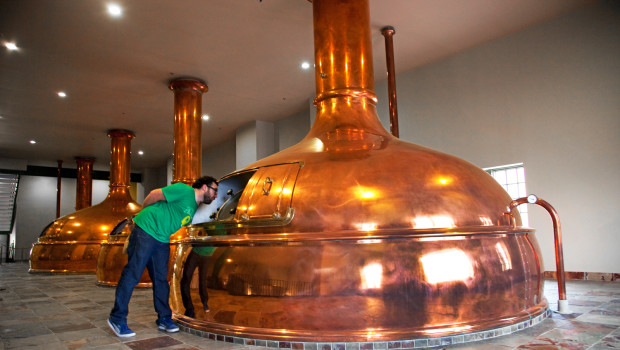What Do The Ingredients of Beer Have To Do With Sailing
Published on October 3rd, 2012
by Glenn McCarthy, Lake Michigan SuRF Newsletter
Put hops, malt, barley and water in four concrete steel reinforced silos and do not mix them, what do you get? Nothing good! Mix them together and you get beer, something real good.
We broke off Junior Sailing /Sailing Schools into their own silo. These programs are growing, everyone involved is enthusiastic. We broke off High School sailing into their own silo. It is one of the greatest success stories in sailing today, more and more High Schools are signing up and competing against one another. Collegiate Sailing is in its own silo. While more mature, it is also growing today. Adult sailing is in its own silo. Just like the Beer example, we leave these four ingredients in their own silos and do not mix them. And what do we have? Nothing good at the end of the day! Adult sailing is struggling at most levels.
There are 300,000 juniors between the ages of 5 and 21 in their three silos in this country. By age 22, 95% of them have quit sailing. Why? It is all about “peers.” They see their peers quit without ramification, and so they quit too – no loss (see the related story on growing your yacht club membership through your sailing school, there is a golden lining). We have been justifying that when sailors get out of college they are busy establishing themselves in the working world, changing jobs frequently, getting housing, moving regularly to get better deals, dating, going to weddings, getting married themselves, having children, etc. Wait a moment there, isn’t that the exact same stuff we did at that age and didn’t we keep sailing? Why is this now an excuse not to sail?
We (I’m a boomer) kept sailing because when we were juniors, we sailed with adults. They were part of our peer group. We saw sailors in their 20’s, 30’s, 40’s, 50’s, 60’s, 70’s, 80’s and a few hanger-ons in their 90’s who all sailed. We knew that they were part of our peers. We knew that we, too, would be sailing for a lifetime. This cycle has been broken.
It was never an intention to segregate the age groups, we enjoyed racing with all ages on board. I remember sailing on Inferno in the early 1970’s, a red C&C 52 owned by Jim McHugh (McHugh Construction Company) when I was about 12. This was the days of RDF, before Loran or GPS. It was a long distance single-day course race in which we were the lead boat. The navigator hailed to the crew “I owe a beer to whoever can spot the mark.” I said, “It’s right up ahead, a little to the right of our course.”
All of the crew looked and looked and couldn’t see it and started to disbelieve me. I said, “It is white on top, orange in the middle and white on the bottom.” The navigator knew the colors of the mark and said there was no way I could have guessed that and I must be seeing it. We sailed to it and rounded it; it was our mark. The point being, I was helpful to the team at age 12, they understood I contributed to the team, and I became one of them right at that moment, having earned my spot. (To the Inferno navigator: I forgot your name, I’m old enough now and you still owe me that beer. Call me).
If the silo system for young sailors was in place back then, I would not have been on Inferno, I would have been at some Opti or 420 regatta somewhere, with helicopter parents shuttling me around. These helicopter parents are spending tons on boats, traveling, coaches, housing, etc., for what long term purpose? The end result is that their kids stop sailing when they are out of college? No life-long exercise, no life-long mentors (in sailing and in business), and no networking? A huge opportunity for young sailors is being missed.
Unintentionally, and only with the greatest goals in mind, we have segregated the sport of sailboat racing. It’s not that we need a Civil Rights movement to fix it, we just need to realize what it is we have done to ourselves and fix it, quickly. Segregation tore this country apart, leading to the greatest loss of American lives in the Civil War in 1861.
The Emancipation Proclamation did not go far enough, and still it took a long time to get the Civil Rights amendment to the Constitution in 1964. Let’s not take that long! Is there any wonder why we struggle to find crew for adult racing when we have cut off our source of crew by building these silos? Is it any wonder why adult regattas are shrinking where the feeder system supplying crews has been shut off? Across the country there are fledgling programs attempting to mix the ingredients of sailing. US Sailing has a program called “Juniors on Big Boats” (created through our local Don Glasell), there have been some Safety at Sea Seminars just for Juniors, and other efforts are being attempted across the country.
Weigh these options, pick one, and network Juniors, Sailing Schools, High Schools, Collegiate and Adult sailing as quick as humanly possible.
OPTION 1 – EASY PROGRAM
Let me make it simple. Those juniors in sailing school, Optis or 420’s, High School, and College Sailing need to have their names and email addresses converted into a crew list and made available to adult sailors. This is best done at the club level. Commercial and government schools are also trying to figure out how to mate up their students to established sailors, reach out to them and add their students to your club’s crew list. Again, all that is needed is a Crew list service (do not charge for this service, it causes huge legal and insurance consequences, especially for the boat owner, contact me if you need these answers). The juniors need to get on Adult one-design boats (Stars, Thistles, Rainbows, Lasers, etc.) and also on Offshore boats. As a Youth, I was asked to crew with Olympic Bronze Medalist Bill Parks in my early teens. He simply called and asked if I was available to crew on the coming weekend. See, mixing those ingredients worked!
OPTION 2 – COMPLICATED PROGRAM
The US SAILING “Juniors on Big Boats” program is another alternative. While our good friend, Don Glasell, brought the idea forward and the late Lake Michigan sailor Tom Neill helped fund the concept, it was hijacked by the sailing school people who saw an opportunity to make money. So, the program was designed so that parents of kids pay the sailing schools to have the sailing school get the kids on Adult big boats. When it comes to money passing hands, they only way to mitigate part of the legality and part of the insurance complications is to become a part of a US Sailing Juniors on Big Boats program and follow all of the rules of the program. Volunteer boat owners must follow a teaching regimen which includes carrying an US Sailing instructor who teaches safety, communications, teamwork, instructing on all positions including helm, main, jib, spinnaker, pit, mast and bow. Handouts include suggested drills, curriculum, and student hand-out materials. Expectation lists are provided for students, parents and boat owners. US Sailing got a determination letter from the US Coast Guard stating that the kids boarding your boat do not meet the Passenger for Hire requirements.
However, in almost all personal yacht policies there are other exclusions, such as “commercial use” of your vessel and Jones Act, where a paid employee – instructor – is on your boat and probably subject to the Jones Act whose coverage you’ll only be able to get on your policy (half of insurers don’t even offer this coverage). In review, there are many, many legal and insurance issues because money is involved.
My personal recommendation is to use the KISS method (Keep It Simple Stupid) by using the Easy Program in Option 1 above.
Reprinted with permission from the October 2012 Lake Michigan Sail Racing Federation Newsletter









 We’ll keep your information safe.
We’ll keep your information safe.